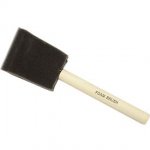- Joined
- Jun 20, 2008
- Messages
- 106,580
- Reaction score
- 98,349
- Gender
- Male
- Political Leaning
- Independent
I have a piece of wood that I need to polyurethane and give a strong protective shell. My equipment:
A soft, even synthetic brush, three inches wide.
The mahogany piece of wood, 18" x 12".
Varathane water-based polyurethane, gloss interior
5" DeWalt random orbit sander with 420 grit sandpaper.
Following instructions as I have understood them, I brush the polyurethane evenly and thinly in one direction, wait a couple hours, brush a new coat in the perpendicular direction, and repeat this process a couple more times.
The problem: the polyurethane never thoroughly settles, leaving me with a crosshatch pattern from the brush ridges on the surface. However lightly I use the sander to even out the surface, I take it down to the wood every single time, no matter what. The main issue here is that it is functionally necessary for the surface of the wood to be 100% flat. Any raised ridges, however slight, are a no-go.
Any advice for applying a completely even surface? I'm dying over here...
A soft, even synthetic brush, three inches wide.
The mahogany piece of wood, 18" x 12".
Varathane water-based polyurethane, gloss interior
5" DeWalt random orbit sander with 420 grit sandpaper.
Following instructions as I have understood them, I brush the polyurethane evenly and thinly in one direction, wait a couple hours, brush a new coat in the perpendicular direction, and repeat this process a couple more times.
The problem: the polyurethane never thoroughly settles, leaving me with a crosshatch pattern from the brush ridges on the surface. However lightly I use the sander to even out the surface, I take it down to the wood every single time, no matter what. The main issue here is that it is functionally necessary for the surface of the wood to be 100% flat. Any raised ridges, however slight, are a no-go.
Any advice for applying a completely even surface? I'm dying over here...

